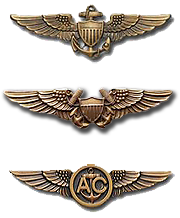Building Bridges (with Black Shoes) - 1996

PATRON FORTY-FIVE is deployed to the Mediterranean (August ‘96) and is a unit under Commander Task Force Sixty-Seven for four months. Operating primarily from NAS Sigonella, Sicily, VP-45 supports the NATO Implementing Forces in Bosnia, executes Sixth Fleet mission and exercise requirements, and supports the deployed carrier battlegroup (TF-60).
"We went flying with VP-45 to build a bridge," says Commander Destroyer Squadron Two Six (CDS-26) Commodore John G. Morgan, Jr. following a mission with the Pelicans of Patrol Squadron Forty-Five. Recent operations in the Mediterranean have highlighted the benefits of mutual support between destroyers and patrol squadrons in today’s naval operations. "I have always been a big fan of maritime patrol aircraft. Today, they are more important than ever in executing my responsibilities as the Sea Combat Commander for the George Washington Battlegroup," explains Commodore Morgan.
The Sea Combat Commander (SCC) is a consolidated warfare commander responsible for surface and undersea warfare as sell as maritime interception, offensive mining and helicopter coordination. The SCC concept provides for a single warfare command authority for the apportionment of a battle- groups destroyers. frigates, submarines, and naval air forces, such as maritime patrol aircraft (MPA). The ability to call upon MPA expands the battlegroup’s realm of influence and provides identification of potential dangers or threats at great distances from the battlegroup. The endurance of MPA aircraft and its advanced systems eases the strain on the carrier air wing and allows the air wing to focus on power projection requirements.
"Maritime patrol aircraft are in major demand because they are versatile, multi- mission capable and, most importantly, they can help resolve the daunting task of identifying ships and subs in the areas of shallower water close to land known as the littoral." continues Commodore Morgan. "The maritime patrol aircraft of VP-45 are just what the doctor ordered for today’s littoral ops. They are agile, responsive, innovative and capable of staying on station for a long time. What more could a commander want?"
Under the leadership of Rear Admiral John R. Ryan, Commander Task Force Sixty-Seven (CTF-67), operational commander for all P-3 maritime aircraft in the Mediterranean, patrol squadrons are performing a wide range of missions. But that’s not new. Although their primary mission is often thought to be Undersea Warfare (USW), as far back as World War II maritime patrol aircraft have done a lot more than just USW. From ocean surveillance to overland intelligence collection, from search and rescue to aerial mining, the maritime patrol (P-3) community is accustomed to tailoring its support to the mission at hand. These attributes were demonstrated in World War II, Korea, Vietnam, the Gulf War, and continues today.
LCDR Stephen W. Hampton, DESRON 26 Chief Staff Officer, accompanied Commodore Morgan on the P-3 mission. "The demands of surveillance and proper identification in the littoral regions of the world require that tactical decision makers understand completely the identification capabilities of platforms like the P-3. Both aviation and surface warfare team members must have confidence in each other’s systems and understand system limitations. Our flight with the professionals of is deployed to the Mediterranean (August ‘96) and is a unit under Commander Task Force Sixty-Seven for four months. Operating primarily from NAS Sigonella, Sicily, VP-45 supports the NATO Implementing Forces in Bosnia, executes Sixth Fleet mission and exercise requirements, and supports the deployed carrier battlegroup (TF-60).
"We went flying with VP-45 to build a bridge," says Commander Destroyer Squadron Two Six (CDS-26) Commodore John G. Morgan, Jr. following a mission with the Pelicans of Patrol Squadron Forty-Five. Recent operations in the Mediterranean have highlighted the benefits of mutual support between destroyers and patrol squadrons in today’s naval operations. "I have always been a big fan of maritime patrol aircraft. Today, they are more important than ever in executing my responsibilities as the Sea Combat Commander for the George Washington Battlegroup," explains Commodore Morgan.
The Sea Combat Commander (SCC) is a consolidated warfare commander responsible for surface and undersea warfare as sell as maritime interception, offensive mining and helicopter coordination. The SCC concept provides for a single warfare command authority for the apportionment of a battle- groups destroyers. frigates, submarines, and naval air forces, such as maritime patrol aircraft (MPA). The ability to call upon MPA expands the battlegroup’s realm of influence and provides identification of potential dangers or threats at great distances from the battlegroup. The endurance of MPA aircraft and its advanced systems eases the strain on the carrier air wing and allows the air wing to focus on power projection requirements.
"Maritime patrol aircraft are in major demand because they are versatile, multi- mission capable and, most importantly, they can help resolve the daunting task of identifying ships and subs in the areas of shallower water close to land known as the littoral." continues Commodore Morgan. "The maritime patrol aircraft of VP-45 are just what the doctor ordered for today’s littoral ops. They are agile, responsive, innovative and capable of staying on station for a long time. What more could a commander want?"
Under the leadership of Rear Admiral John R. Ryan, Commander Task Force Sixty-Seven (CTF-67), operational commander for all P-3 maritime aircraft in the Mediterranean, patrol squadrons are performing a wide range of missions. But that’s not new. Although their primary mission is often thought to be Undersea Warfare (USW), as far back as World War II maritime patrol aircraft have done a lot more than just USW. From ocean surveillance to overland intelligence collection, from search and rescue to aerial mining, the maritime patrol (P-3) community is accustomed to tailoring its support to the mission at hand. These attributes were demonstrated in World War II, Korea, Vietnam, the Gulf War, and continues today.
LCDR Stephen W. Hampton, DESRON 26 Chief Staff Officer, accompanied Commodore Morgan on the P-3 mission. "The demands of surveillance and proper identification in the littoral regions of the world require that tactical decision makers understand completely the identification capabilities of platforms like the P-3. Both aviation and surface warfare team members must have confidence in each other’s systems and understand system limitations. Our flight with the professionals of VP-45 helped provide that understanding," he said.
In reciprocation, DESRON TWO-SIX invited representatives of VP-45 to sail in USS George Washington (CVN-73) during exercise FREEDOM 96-3 and in USS Arthur W. Radford (DD-968) for exercise SHAREM 117. Both exercises flexed the integrated concept of forward deployed VP squadrons.
Working with the DESRON 26 team, LCDR P. H. McDevitt and LT Cory Bouck of VP-45 played a major role in planning and executing surface and undersea surveillance during the Adriatic exercise FREEDOM 96-3. "Getting a glimpse of how our information is used to build a sub-surface picture was totally new to me," stated LT Bouck as he stood watch in WASHINGTON’S Combat Direction Center.
LCDR McDevitt added that, "My understanding of how P-3 aircraft integrate and add to this battlegroup’s surveillance capability is critical to our ability to provide quality, useful data to the battlegroup decision makers. Cross-training with the ships and the staff of DESRON 26 during real-world operations is a true benefit of our deployment." LT Slate Johnson, also of VP-45, was also a key factor in successfully coordinating VP-45’s operations during SHAREM 117.
Embarked on USS RADFORD, LT Johnson flew with HSL-46’s Detachment Seven in a mission against a simulated enemy submarine. He stated, "It was a completely different perspective to be in the helicopter. We frequently conduct coordinated operations with SH-60B helicopters. When I fly TACCO (Tactical Coordinator) in the P-3, I am often tasked as the Scene of Action Commander and control the coordinated tactics. My helo ride helped me better understand how the other guys work."
Send questions, comments or suggestions regarding this website to: vp45assoc@vp45association.org
Copyright © 2005 PATRON FOUR FIVE ASSOCIATION


